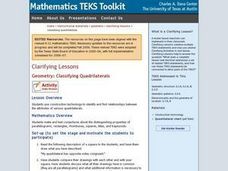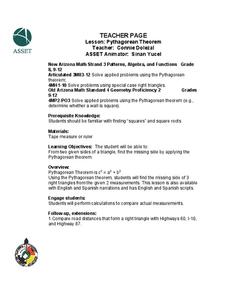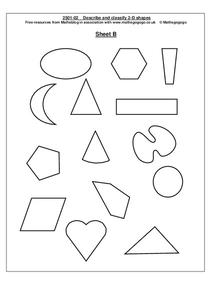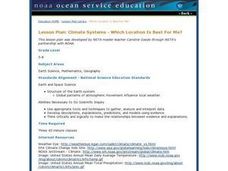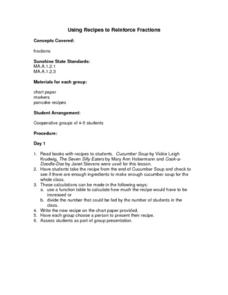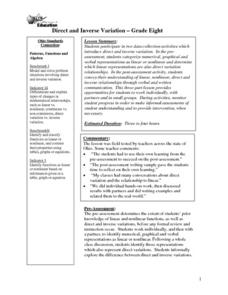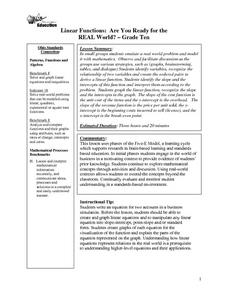Curated OER
The Mandelbrot Set
Students are introduced to the notion of a complex number and function iteration in order to motivate the discussion of Julia sets and the Mandelbrot set.
Curated OER
Shape Detectives
Students become "shape detectives" as they identify, name, create and describe common shapes within pictures and objects found within the learning environment. Suggestions include incorporating shapes into all learning areas and daily...
Curated OER
Introduction to Linear Functions
Students are introduced to the concept of linear functions. Using new terminology, they describe linear functions in sentences and in data tables. Using the internet, they calculate and record answers to problems which are discussed...
Curated OER
Will There be Enough Water?
Students investigate water usage, water available, and water demand historically in the local area. They use projections of water usage, availability and demand up to the year 2050. Students use graphs to relate as well as compare and...
Curated OER
Geometry: Classifying Quadrilaterals
Students use construction technology to identify and find relationships between the attributes of various quadrilaterals. They make and test conjectures about the distinguishing properties of parallelograms, rectangles, rhombuses,...
Curated OER
Transformation: Reflection
Tenth graders identify and analyze appropriate key vocabulary terms associated with transformations and reflection. Students experience creating and recognizing reflection with hands-on manipulations. Students discover real-world...
Curated OER
Spring Potted Plants
Students identify and interpret plant growth as well as gain graphing skills and other important knowledge related to potting plants. They take a regular milk jug and cut off the top, leaving the handle and the rest intact. Then,...
Curated OER
Design a Better Classroom Workplace
Students design a new classroom workplace. In this architecture activity, students use area formulas to identify the problem with the existing desks in their classroom. Students design their own solution volume formulas to solve the...
Curated OER
Number Dribble
Students dribble and catch a ball. In this number dribble lesson students are given numbers and math equations that require them to dribble or throw the ball a specific number of times. The students practice dribbling independently and...
Curated OER
Problem Solving Using Power Polygons
Students investigate geometric shapes by creating figures on a plane. In this polygon lesson, students complete a worksheet based on the angles in a power polygon. Students identify the different types of polygons and define their...
Curated OER
Slippery Slope
Students define patterns, relation and function. In this algebra lesson, students find the slope of a line and write equations of line. They model the slope using real life scenarios.
Curated OER
How Sharp Is Your Memory?
Students play a memory game as they explore reasoning. In this algebra lesson, students identify concepts using pictures and words. They model real life scenarios using hands on manipulatives.
Curated OER
Pythagorean Theorem
Students apply properties of Pythagorean to solve problems. In this geometry lesson, students identify the different parts of a right triangle using ratios. they solve problems using squares and square roots.
Curated OER
Shapes
In this shapes worksheet, students identify shapes according to sentences that describe them. Students identify 8 shapes, but have 14 to choose from.
Curated OER
A Trip to the Toy Store
First graders recognize and identify the value of a penny, nickel and dime. They spend play money in a simulated toy store and match their coins to the purchase price of a toy of their choice.
Curated OER
Water - Planning for the Future
Middle schoolers explore and examine the increases and/or decreases for water user groups: irrigation, municipal, manufacturing, steam electric power generation cooling, livestock, and mining. They utilize percentage changes during their...
Curated OER
ARE YOU A TRIANGULATEER?
Students explore about triangles and their relationship to the worlld around them. They are able to identify triangular shapes in their environment. Students are able to communicate to one another their understanding of triangles outside...
Curated OER
Gee's Bend Quilts Three
Third graders identify and practice sewing a dashed line in an arch shape. They identify with five new facts about quilts, women, and the community of Gee's Bend. Finally, 3rd graders complete the quilt top, batting and backing together.
Curated OER
Climate Systems - Which Location Is Best For Me?
Students study the difference between weather and climate. In this climate systems lesson plan students search the Internet for the parts of the Earth's system, gather climate data and complete a challenge scenario.
Curated OER
Equilateral Triangles
Students examine the attribute of equilateral triangles. In this equilateral triangle lesson plan, students examine a number of paper triangles to determine how they are classified. They determine how triangles are depicted in Navajo rugs.
Curated OER
Wildlife Sampling-Capture-Recapture
Seventh graders simulate the capture-recapture method of population sampling using beans. In this biology instructional activity, 7th graders calculate the total population of beans in the bowl. They assess whether this method is...
Curated OER
Using Recipes To Reinforce Fractions
Students calculate fractions used in various food recipes in this Math lesson with real world applications. The lesson is geared towards upper elementary students but can be adapted for various levels of learners. State math standards...
Curated OER
Direct and Inverse Variation
Eighth graders participate in two data collection activities that involve direct and inverse variation. In the pre-assessment, 8th graders categorize numerical, graphical, and verbal representations as linear or nonlinear and determine...
Curated OER
Linear Functions: Are You Ready for the REAL World?
students emulate a real world problem and model it with mathematics working in a small group. Observe and facilitate discussion as the groups use various strategies, such as (graphs, brainstorming, tables, and dialogue.




